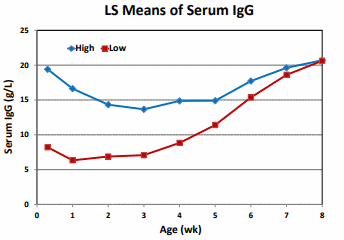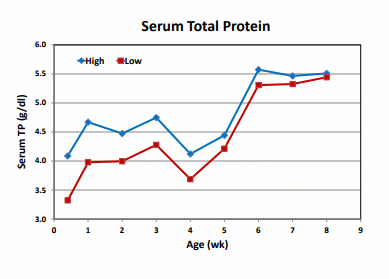Changes in serum IgG and total protein concentrations in calves fed differing amounts of colostrum replacer
It is unclear whether differences in serum IgG concentration of calves at 24 h (acquired passive immunity) influence the onset of active IgG production or the age at which serum IgG concentrations normalize. Our objective was to monitor changes in serum IgG and total protein (TP) concentrations in calves fed to achieve high (H) or low (L) passive immunity. Newborn Holstein calves (initial BW = 42.2 ± 4.7 kg) were individually fed a colostrum supplement (n = 23; 50 g of IgG/feeding) or a colostrum replacer (n = 22; 150 g of IgG/feeding) at 0.5 ± 0.22, 6.6 ± 0.46, and 12.9 ± 1.94 h of age. Blood was collected and serum analyzed for IgG using radial immunodiffusion and total protein using optical refractometer every 7 d from wk 0 (2-3 d of age) to wk 8. Calves were vaccinated with InforceTM 3 (Zoetis) on arrival, Bovi-shield Gold® 5 (Zoetis) at 2 and 6 wk and Presponse® HM (Boehringer Ingelheim Vetmedica) at 5 and 8 wk, as prescribed by a veterinarian. Data were analyzed as a completely randomized design using repeated measures ANOVA. Serum IgG (g/L) and total protein (TP; g/dl) concentrations at 24 h of age were 19.4 ± 0.63 and 4.07 ± 0.076, respectively, in calves fed H, and 8.52 ± 0.62 and 3.32 ± 0.074, respectively, in calves fed L. Serum IgG and TP were affected by a week x treatment interaction (P < 0.001). Serum IgG concentration in calves fed H declined to 13.7 g/L at wk 3, then increased to 20.7 g/L at wk 8. Serum IgG in calves fed L declined to 6.3 g/L at wk 1, then increased to 20.6 g/L at wk 8. By wk 7, serum IgG concentration were similar (P > 0.05). Serum IgG was < 10 g/L for 0.3 and 4.9 wk in calves fed H and L, respectively. Total protein concentrations were lower in calves fed L from wk 0 to 6 (P < 0.01); thereafter, differences were not significant. Temporal changes in serum TP and IgG concentrations were independent. Active IgG synthesis was dependent on age of calf and acquisition of passive immunity. Calves with lower serum IgG concentrations at wk 0 began producing IgG at an earlier age and produced more IgG, so that by wk 7, circulating IgG concentrations were similar to those in calves with successful passive immunity.
- All doses were prepared in Perfect Udder® packaging and were administered with the esophageal tube feeding attachment.
- Low doses packages were supplemented with 333 g of milk replacer (Nurture® Basic) to provide similar volume of liquid per feeding and to ensure calves received enough calories during the cold weather.
- Calves were transported to the Nurture Research Center and blood was collected at about d 3 of life and every 7 d thereafter. • Blood was analyzed for total protein (TP, refractometer) and IgG (RID).
- Calves were housed in individual pens in a naturally ventilated barn. • Calves were vaccinated according to standard NRC protocol (abstract).
- Mean serum IgG on arrival (2-3 d of age) averaged 19.4 and 8.2 g/L in calves fed H and L, respectively (P < 0.01). Mean serum TP were 4.12 And 3.32 g/dl, respectively (P < 0.01). Although all calves fed H achieved successful passive transfer, serum TP were consistently < 5.2 g/dL, indicating that serum TP ≥ 5.2 g/dl is not a useful estimate of successful passive transfer in calves fed CR.
- Serum IgG concentrations declined to 3 and 1 wk in calves fed H and L, respectively, then increased to 8 wk. Rate of increase in serum IgG concentration was greater in calves fed L so that serum IgG were similar at 8 wk.
- Others have reported exponential decline of maternal IgG from d 1 to about 3 (Devery et al., 1979) or 25 wk of age (Hassig et al., 2007) in calves fed maternal colostrum (MC). Murphy et al. (2014) reported a decline in serum IgG concentration to 5 wk in calves fed MC or a CR derived from MC. Half-life of IgG derived from the CR was shorter (19 d) vs. MC (29 d).
- Increasing concentrations of serum IgG from 3 (H) and 1 (L) wk were consistent with onset of active IgG production, although this is not commonly reported in the literature. Early onset of active IgG production and increased serum IgG was reported by Nonnecke et al. (2012) in colostrum deprived calves but not in calves fed MC.
- Serum TP concentrations were consistently lower in calves fed L to 4 wk; thereafter, concentrations were similar. Changes in serum TP after 1 wk were independent of serum IgG concentrations.
- Onset of active immunity and increasing serum IgG occurs from an early age which is dependent on passive immune status









.jpg&w=3840&q=75)